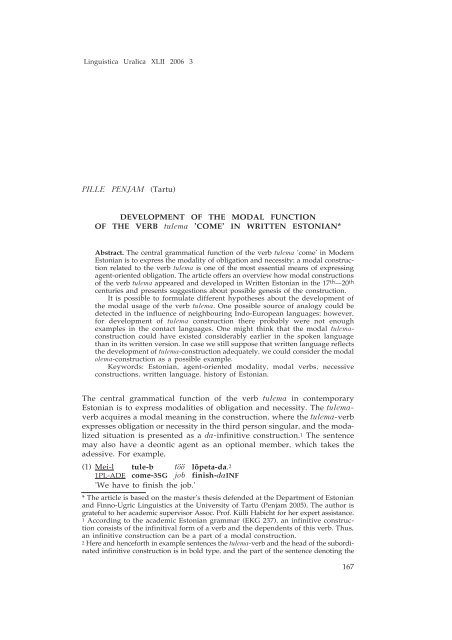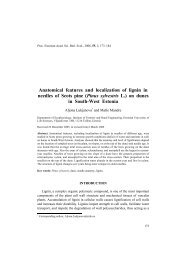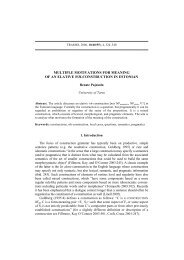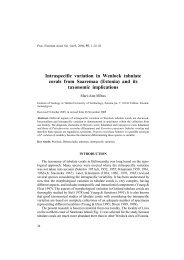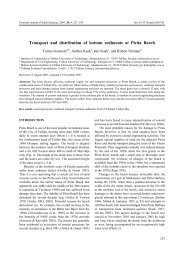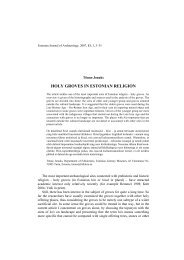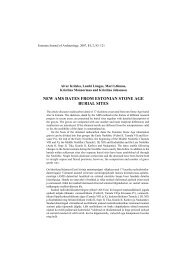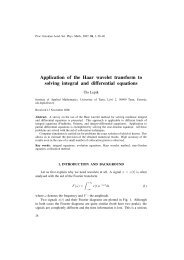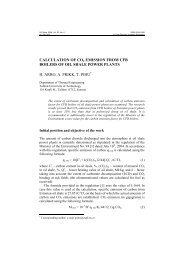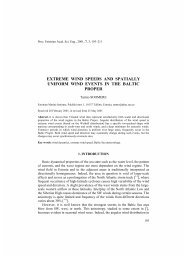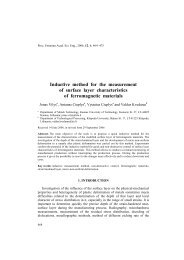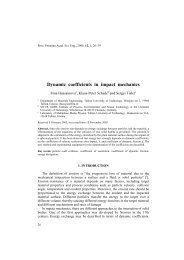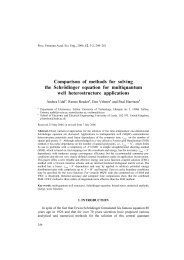PILLE PENJAM (Tartu) DEVELOPMENT OF THE MODAL ... - CEEOL
PILLE PENJAM (Tartu) DEVELOPMENT OF THE MODAL ... - CEEOL
PILLE PENJAM (Tartu) DEVELOPMENT OF THE MODAL ... - CEEOL
Create successful ePaper yourself
Turn your PDF publications into a flip-book with our unique Google optimized e-Paper software.
Linguistica Uralica XLII 2006 3<br />
<strong>PILLE</strong> <strong>PENJAM</strong> (<strong>Tartu</strong>)<br />
<strong>DEVELOPMENT</strong> <strong>OF</strong> <strong>THE</strong> <strong>MODAL</strong> FUNCTION<br />
<strong>OF</strong> <strong>THE</strong> VERB tulema ’COME’ IN WRITTEN ESTONIAN*<br />
Abstract. The central grammatical function of the verb tulema ’come’ in Modern<br />
Estonian is to express the modality of obligation and necessity; a modal construction<br />
related to the verb tulema is one of the most essential means of expressing<br />
agent-oriented obligation. The article offers an overview how modal constructions<br />
of the verb tulema appeared and developed in Written Estonian in the 17 th —20 th<br />
centuries and presents suggestions about possible genesis of the construction.<br />
It is possible to formulate different hypotheses about the development of<br />
the modal usage of the verb tulema. One possible source of analogy could be<br />
detected in the influence of neighbouring Indo-European languages; however,<br />
for development of tulema construction there probably were not enough<br />
examples in the contact languages. One might think that the modal tulemaconstruction<br />
could have existed considerably earlier in the spoken language<br />
than in its written version. In case we still suppose that written language reflects<br />
the development of tulema-construction adequately, we could consider the modal<br />
olema-construction as a possible example.<br />
Keywords: Estonian, agent-oriented modality, modal verbs, necessive<br />
constructions, written language, history of Estonian.<br />
The central grammatical function of the verb tulema in contemporary<br />
Estonian is to express modalities of obligation and necessity. The tulemaverb<br />
acquires a modal meaning in the construction, where the tulema-verb<br />
expresses obligation or necessity in the third person singular, and the modalized<br />
situation is presented as a da-infinitive construction.1 The sentence<br />
may also have a deontic agent as an optional member, which takes the<br />
adessive. For example,<br />
(1) Mei-l tule-b töö lõpeta-da.2<br />
1PL-ADE come-3SG job finish-daINF<br />
’We have to finish the job.’<br />
* The article is based on the master’s thesis defended at the Department of Estonian<br />
and Finno-Ugric Linguistics at the University of <strong>Tartu</strong> (Penjam 2005). The author is<br />
grateful to her academic supervisor Assoc. Prof. Külli Habicht for her expert assistance.<br />
1 According to the academic Estonian grammar (EKG 237), an infinitive construction<br />
consists of the infinitival form of a verb and the dependents of this verb. Thus,<br />
an infinitive construction can be a part of a modal construction.<br />
2 Here and henceforth in example sentences the tulema-verb and the head of the subordinated<br />
infinitive construction is in bold type, and the part of the sentence denoting the<br />
167
Pille Penjam<br />
A similar modal construction based on the tulema-verb can be found<br />
also in other Finnic languages (Saukkonen 1965 : 150—155).<br />
The modal construction with the verb tulema together with the verb<br />
pidama ’must’ with the same meaning are important means of expressing<br />
agent-oriented necessity in Estonian; in some text types it is even the most<br />
frequent means (Nurmi 1991 : 735). Against this background it is somewhat<br />
unexpected that in the older survived Estonian-language texts the<br />
verb tulema does not occur in the modal meaning. It serves as a basis for<br />
the hypothesis that the data of Old Written Estonian could show the development<br />
of the modal use of the verb tulema (Habicht 2001 : 273).<br />
The article provides a survey of the appearance and development of<br />
the modal tulema-construction in written Estonian from the 17 th to the 20 th<br />
centuries, and assumptions will be made about the possible origin of the<br />
construction. The analysis is based on a 5,438-page sample of North Estonian<br />
written texts from 1600—1850; the data from the end of the 19 th century<br />
and the 20 th century come from the <strong>Tartu</strong> University Corpus of Estonian<br />
Literary Language (1890—2000; http://test.cl.ut.ee/korpused/baaskorpus).<br />
1. Estonian modal tulema-construction in the light of construction grammar<br />
and grammaticalization theory<br />
In contemporary linguistics the concept of construction grammar covers a<br />
number of different research trends. In this article construction grammar<br />
means only the classical trend of contruction grammar, as represented by<br />
Charles Fillmore, Paul Kay, George Lakoff, and Adele Goldberg (see e.g.<br />
Goldberg 1995; Fried, Östman 2004; Östman, Fried 2005, Fillmore, Kay,<br />
O’Connor 1988; Kay, Fillmore 1997).<br />
A. Goldberg (1995 : 4) in her treatment of argument structure constructions<br />
of verbs defines the main term of construction grammar, the construction,<br />
as follows: ”C is a construction iff def C is a form—meaning pair <br />
such that some aspect of F i or some aspect of S i is not strictly predictable<br />
from C’s component parts or from other previously established constructions.”<br />
Thus, in construction grammar form and function are regarded as<br />
inseparable from each other (Fried, Östman 2004 : 12); the description of<br />
a grammatical construction includes at the same time information about<br />
the morphosyntactic properties, prosodic and phonetic shape, meaning,<br />
and function of the construction (Fried, Östman 2004 : 19—23).<br />
A. Goldberg (1995) described the argument structure constructions of<br />
verbs in great detail from the perspective of construction grammar. The<br />
main claim of A. Goldberg’s monograph could be worded as follows: the<br />
constructions of the principal clause types are independent correspondences<br />
of form and meaning, the semantic side of which cannot be reduced to<br />
the meanings of the words occurring in the sentence. The final interpretation<br />
of a specific sentence (construct) is formed as a combination of the<br />
meanings of the words in the sentence and the meaning of the syntactic<br />
construction (Goldberg 1995 : 9—10).<br />
The modal use of the tulema-verb in contemporary Estonian presumes<br />
a definite sentence pattern: (AG ade) V 3SG DA (the abbreviation AG ade denotes<br />
agent of modality is underlined. Italics mark the part of the sentence that is analysed<br />
as the object of the infinitive construction in contemporary Estonian grammar.<br />
168
Development of the Modal Function of the Verb tulema ’come’...<br />
an adessive agent, V 3SG stands for a verb in the third person singular, and<br />
DA is the da-infinitive), a modalized situation can be expressed only as an<br />
infinitive construction (Rätsep 1978 : 35—39, 188; EKG 182). Thus, the modal<br />
meaning of the tulema-verb is first and foremost a constructional meaning;<br />
the verb can acquire a modal meaning only in a definite syntactic environment<br />
(Pajusalu, Tragel, Veismann, Vija 2004 : 30—31), and it is convenient<br />
to describe the semantics of the tulema-verb in the modal construction by<br />
means of the tools and concepts of construction grammar.<br />
Most studies in the vein of construction grammar describe language from<br />
the synchronic aspect, discussing only briefly the historical development of a<br />
language (e.g. Goldberg 1995 : 132, but see also Leino 2003 : 63—118). Nevertheless,<br />
at first sight one cannot see any conflicting circumstance between the<br />
language description according to construction grammar and the generally<br />
accepted understanding regularities with regard to the historical development<br />
of languages and grammaticalization. Michael Israel (1996) analysed the development<br />
of the way-construction in English, and his treatment fully supports<br />
the view that the construction develops in accordance with the previously<br />
described principles of the grammaticalization process — changes take place<br />
in the course of a long time, the conceptual content of the construction has<br />
extended gradually, the original concrete content has been replaced by more<br />
abstract content; the form of the construction has become increasingly fossilized;<br />
its frequency has increased (see e.g. Heine, Claudi, Hünnemeyer 1991; Heine,<br />
Kuteva 2002; Hopper, Traugott 1993; Bybee, Perkins, Pagliuca 1994; Diewald<br />
1997; New Reflections on Grammaticalization 2002).<br />
Construction grammar and grammaticalization theory can be linked<br />
also from another aspect by describing the grammaticalization of a lexicon<br />
unit as transition of the unit to such an unproductive grammatical<br />
construction where it had not occurred previously.<br />
At first lexicon units are grammaticalized only in a certain semantically<br />
and grammatically narrowly demarcated environment. Therefore,<br />
researchers have claimed that it would more appropriate to speak about<br />
the grammaticalization of constructions rather than that of single words<br />
and forms (Bybee, Perkins, Pagliuca 1994 : 11; Hopper, Traugott 1993 : 4);<br />
the grammaticalization of the construction-related word form is only a side<br />
effect of grammaticalization (Lehmann 2002 : 7). The basis for creating a new<br />
construction is its similarity to previous constructions (Itkonen 2002 : 418).<br />
Therefore, many cases of grammaticalization could be explained not as<br />
grammaticalization of the construction but as conventionalization of a new<br />
lexicon unit in a previously existing grammatical construction where this<br />
specific unit had not occurred previously. It is likely that also the origin of<br />
the modal tulema-construction could be analysed as integration of a new<br />
lexicon unit, the tulema-verb, with the unproductive necessive construction<br />
(the abbreviation N ade denotes an adessive noun, V 3SG<br />
stands for a verb in the third person singular, and V DA is the da-infinitive).<br />
2. The modal tulema-construction in Old Written Estonian<br />
The material of the old written language revealed 4,929 occurrences of the<br />
tulema-verb; in 114 cases the verb was used modally (2.3% of all the<br />
occurrences of the tulema-verb in the old written language). In 108 cases<br />
169
Pille Penjam<br />
the tulema-verb was almost clearly used modally; there were six more<br />
instances where the modal meaning could be regarded primary but an<br />
alternative interpretation is possible, too. The modal construction is absent<br />
in the oldest texts; the earliest examples date from the last decade of the<br />
17th century, e.g.<br />
(2) Agga et sesamma [=kirikuseaduse] sees sedda üxpeine on sädut/ mis<br />
keikennamist Kirko Asja on/ ja et mitte korra perrast echk issipeine on<br />
kirjotut/ mis Iutlusse Ammeti monnisuggust Asja Ajamissel tulle-p<br />
what come-3SG<br />
Kirko Wisi nink kombe echk monne mu issipeinse Luggu polest<br />
tähhelepan-na … (Kässi-Ramat 1699 : i—ii)<br />
pay attention-daINF<br />
’But that in this ecclesiastical book it is only provided what church<br />
matters are, and that it has not been written separately what one needs<br />
to pay attention to while taking care of the business of the preacher’s<br />
profession in connection with the ways and customs of the church or<br />
some other peculiar episode …’<br />
In the next centuries the modal use is already rather common; one can<br />
find such examples in almost all the texts from the 18 th and the 19 th centuries.<br />
However, the number of modal constructions by comparison with the number<br />
of all the occurrences of the tulema-verb is still rather small, with the exception<br />
of legal acts and texts providing various kinds of practical advice. Such<br />
a finding can be regarded as expected because the need to express modal<br />
meanings is much lower in narrative texts than in non-fiction texts.<br />
2.1. The meaning and functions of the modal tulema-construction in the<br />
old written language<br />
In modally interpreted sentences the semantics and functions of the tulemaverb<br />
(or rather those of the related construction) are similar to contemporary<br />
language — the tulema-construction is used to convey necessity<br />
and obligation modality, e.g.<br />
(3) Osta siis ennesele nisuggust riet, mis saksad nimmetawad: marliks; tee<br />
sest kotti, kellel pitkus 2 künart ja laius 11 ⁄4 künart pohjas on, seält<br />
tulle-b ta nenda kitsoke leika-da,<br />
come-3SG 3SG cut-daINF<br />
et kotti su laius ei olle ennam kui 1 ⁄2 künart. (Willmann 1782 : 195)<br />
’Buy then the kind of cloth that the Germans call gauze; make a sack<br />
from it that is two ells in length and the width from the bottom is 11 ⁄4<br />
ells; there you’ll have to cut it so narrow that the opening of the sack<br />
will not exceed 1 ⁄2 ells.’<br />
(4) Seddasinnas-t seädus-t tulle-b ka selle tallomehhe jures täita,<br />
this-PRT law-PRT come-3SG apply+daINF<br />
kes kulutanud, et koggodussest tahhab wäljaminna. (Seäduste-täitmisse<br />
tükkid 1845 : 10)<br />
’This law must be applied also to the farmer who has said that he<br />
wishes to leave the congregation.’<br />
170
Development of the Modal Function of the Verb tulema ’come’...<br />
Usually the agent of obligation is not expressed in the sentence; modal<br />
obligation / necessity is directed at the generic person (5), or the agent<br />
becomes clear from the context (6), e.g.<br />
(5) Kui üks kerbne arwab, et keik koggematta mailma sees on sündind, siis<br />
se tulle-b mitte pahhaks- pan-na... (Willmann 1782 : 34)<br />
it come-3SG NEG disapprove-daINF<br />
’If a fly thinks that everything has happened in the world by chance,<br />
then one should not disapprove of it...’<br />
(6) Oli Westen äratunnud, et lugu nendega nenda, siis teadis tema kaa,<br />
mis tul-i-Ø teh-a. (Toomas Westen 1844 : 18)<br />
what come-IMPF-3SG do-daINF<br />
’Once Westen had realized the situation they were in, then he also<br />
knew what had to be done.’<br />
It is difficult to assess whether necessity/obligation expressed by means<br />
of the tulema-construction is of the same degree of intensity as nowadays.<br />
On the basis of only a few examples one might assume that the tulemaconstruction<br />
could be interpreted somewhat softer than now. In two<br />
instances the tulema-construction expressed a promise rather than an<br />
obligation, e.g.<br />
(7) Wimaks läksid [prouad ja preilid] temmaga tantsima, siis olli kärra öige<br />
lahti, sest se tulle-b kül arwa-da<br />
it come-3SG imagine-daINF<br />
kuida temma [joobnud talupoeg] teistega on tantsind. (Willmann 1782 : 62)<br />
’Eventually [married women and young ladies] went to dance with him;<br />
all hell broke loose then because one might imagine how he [drunken<br />
peasant] was dancing with the others.’<br />
In one case the tulema- and pidama-constructions were used side by<br />
side, whereas one gets the impression that the pidama-construction adds<br />
intensity to the obligation:<br />
(8) Mis tulle-b tehh-a, ja mis pea-d tegge-ma,<br />
what come-3SG do-daINF and what must-2SG do-maINF<br />
kui innimesed sind ehk parremaks ehk pahhemaks peawad, kui sa ei<br />
olle? (Masing 1824 : 35)<br />
’What one has to do and what have you to do if people regard you<br />
better or worse than you are?’<br />
Because in contemporary Estonian the pidama- and tulema-constructions<br />
are almost synonymous,3 this intensifying use leads us to the idea<br />
that even in the 19th century obligation expressed by the tulema-verb was<br />
perceived more weakly than in the contemporary language.<br />
From the perspective of the development of the modal construction<br />
such examples are of special interest where the meaning of the tulemaverb<br />
allows multiple interpretations. However, the sample had few such<br />
examples, and in all these cases the modal interpretation seems to be<br />
primary.<br />
3 By comparison it is worth mentioning that in contemporary Finnish the deontic<br />
force of the tulla-construction is clearly weaker than that of the pidama-construction<br />
(Kangasniemi 1992 : 100).<br />
171
Pille Penjam<br />
In the case of one example the possibility of multiple interpretations<br />
is totally accidental. In the sentence (9) the da-infinitive construction is<br />
subordinated to the tulema-verb, and the construction is likely to carry the<br />
meaning of general necessity.<br />
(9) senni kui Jummal neile wimaks ühte Kunningast andis nende Palwede<br />
peäle, tulle-b ühtekokko-arwa-ta liggimalt kolmsada ja<br />
come-3SG add up-daINF almost three hundred and<br />
nellikümmend Aasta-d. (Jummala surest Teggudest 1789 : 334)<br />
forty year-PRT/PL_NOM<br />
’until eventually God gave them a king in response to their request, it<br />
has to be considered altogether almost 340 years’ / ’it took altogether<br />
almost 340 years.’<br />
At the same time it is possible to interpret the sentence this way that<br />
the meaning of the tulema-verb is ’be added up’ and the da-infinitive<br />
construction acts rather in the function of the gerund, cf.<br />
(10) aega seni, kuni Jumal neile viimaks ühe kuninga andis,<br />
tule-b ühtekokku-arwa-tes liggimalt kolmsada ja<br />
come-3SG add up-GER almost three hundred and<br />
nellikümmend Aasta-d. (Jummala surest Teggudest 1789 : 334)<br />
forty year-PRT/PL_NOM<br />
’until eventually God gave them a king in response to their request,<br />
it took altogether almost 340 years.’<br />
In four cases one might assume that the tulema-verb acts as a future<br />
auxiliary in the sentence although the primary interpretation would still<br />
be modal, e.g.<br />
(11) Ja Samuel räkis Rahwa ette ueste keik Kunninga Öigust, ja mis Woimus<br />
temmal olleks, ja mis temmale keik tulle-ks-Ø anda<br />
what come-CND-3SG give+daINF<br />
ja maks-ta. (Jummala surest Teggudest 1789 : 389)<br />
and pay-daINF<br />
’And Samuel told the crowd once again about all the rights of the king<br />
and about what kind of power he would enjoy and what should/would<br />
be given and paid to him’.<br />
2.2. Grammatical structure of the modal tulema-constructions in the old<br />
written language<br />
In the necessive construction (AG ADE V 1 3SG V 2 DA) of contemporary Estonian<br />
the V 2 DA role is performed by a non-finite verb form or a longer verb<br />
phrase, to which in turn the object could be subordinated. Thus, in each<br />
case V 2 is embedded in the model together with its dependents, which<br />
should not be regarded as belonging to the necessive construction itself.<br />
Because the old written language includes many examples where the part<br />
of the sentence that is regarded as the object of the infinitive construction<br />
according to the present interpretation agrees with the tulema-verb in<br />
number, it is expedient in the future analysis to consider this part of the<br />
sentence (henceforth N) as being part of the construction.<br />
172
Development of the Modal Function of the Verb tulema ’come’...<br />
The model (AG) tulema (N) DA describes most generally the structure<br />
of the modal construction related to the tulema-verb in the old written<br />
language. Naturally, sentences may additionally have various kinds of<br />
optional members.<br />
In five sentences of the studied material two successively coordinated<br />
da-infinitive constructions are subordinated to the tulema-verb;<br />
one sentence includes three coordinated infinitive constructions — thus,<br />
the following overview is based on 121 modal constructions including<br />
the tulema-verb.<br />
It appears that in the studied material of the old written language the<br />
agent of modality is explicitly represented in 11 cases, that is, in almost<br />
every ten modal constructions related to the tulema-verb.4 If the agent is<br />
present in the sentence, in eight cases it is in the adessive (12) and in three<br />
cases in the allative (13), e.g.<br />
(12) Nende tähtes sannade sees tulle-wad mei-l keige ennamiste<br />
come-3PL 1PL-ADE<br />
kaks asja tähhele-pan-na... (Seitse Paasto-Jutlust 1817 : 56)<br />
two thing+PRT pay attention-daINF<br />
’Of these important words we must pay most attention to two things…’<br />
(13) Se on üks wägga tarwelinne assi, et meie kohhe ärratassume,<br />
kus meie mele middagi tulleb,<br />
mis mei-le tassu-da tulle-b. (Luggemisse-Ramat 1815 : 36)<br />
that 1PL-ALL pay-daINF come-3SG<br />
’It is a highly necessary thing that we will pay off right away when<br />
we recall something that we have to pay for.’<br />
The present examples do not allow making conclusion about the<br />
historical change in preferred forms; it is likely that the adessive and<br />
the allative uses may have competed with each other over several centuries.<br />
It is possible to follow the change in agreement in those constructions<br />
where N is in the plural and the tulema-verb is in the affirmative. It appears<br />
that in the 17th and the 18th centuries N always agreed with the tulemaverb<br />
in the developing necessive construction, which proves that the nominative<br />
N was still interpreted as the subject, e.g.<br />
(14) Wämla-d tulle-wad arwata-da temma wasto körreks,<br />
cudgel-PL come-3PL regard-daINF<br />
ja ta naerab odda kärrinat. (Piibli Ramat 1739 : Iob 41:21)<br />
’Cudgels should be regarded as straws by comparison with him, and<br />
he laughs at the rattle of the spear.’<br />
Non-agreed examples appear in the 19 th century, being in minority at<br />
first and structurally restricted: in all the examples the relative pronoun<br />
mis ’that’ performs the role of N, which is referenced to the plural noun<br />
phrase of the main clause, e.g.<br />
4 The leading articles of Estonian newspapers in 1906—1907 show a similar relative<br />
frequency of the tulema-constructions with the agent; over the 20 th century<br />
the ratio of constructions with the agent has somewhat increased (Nurmi 1991 :<br />
738).<br />
173
Pille Penjam<br />
(15) Agga isse on weel nee-d sure-ma-d süü-d mis<br />
this-PL big-CMP-PL crime-PL that<br />
nenda kui enne sedda, Ullema Kohto holeks tulle-b anda<br />
come-3SG give+daINF<br />
ja jätta. (Jggaüks 1802 : 19)<br />
and leave+daINF<br />
’But the bigger crimes constitute a totally different matter, which, as<br />
previously, should be left to the higher court.’<br />
There are only four sentences that do not include N.<br />
Extensive agreement of the plural N is to some extent in conflict with<br />
the fact that quite often (25 examples, in addition four ambiguous examples)<br />
N is in the partitive and seems to fulfil the function of the object and not<br />
the partial subject in the perception of language users. Examples of partitive<br />
N are numerous already in the 1739 Bible, e.g.<br />
(16) Jummala-t tulle-b wägga karta<br />
God-PRT come-3SG fear+daINF<br />
sures pühhade salajas koggoduses, ja ta on kartusse wäärt keikide jures,<br />
kes temma ümber on. (Piibli Ramat 1739 : Ps 89:8)<br />
’God is fearsome in the secret council of saints, and he is more feared<br />
than anyone else surrounding him.’<br />
The existence of partitive forms, on the one hand, and the agreement<br />
of nominative forms, on the other, enables us to assume that the construction<br />
could be analysed differently depending on the form of N — the partitive<br />
as a prototypical object case suggested the interpretation of the noun<br />
phrase as the object; the nominative N, however, was still perceived as<br />
the subject and not the total object.<br />
Of the moods the modal tulema-construction in the old written language<br />
reveals the indicative and six occurrences of the conditional, which softens<br />
the categoricalness of obligation, e.g.<br />
(17) kül ta siis saaks kuulda, kui Poas tedda seält leiaks, mis temma-l<br />
what 3SG-ADE<br />
tulle-ks-Ø tehh-a. (Jummala surest Teggudest 1789 : 347)<br />
come-CND-3SG do-daINF<br />
’it is sure she will then hear, if Boas found her there, what she should do.’<br />
As expected, the tulema-verb in necessive constructions is mostly in<br />
the present. However, some texts from the second half of the 18th century<br />
and the 19th century reveal also some past uses (six examples), e.g.<br />
(18) Nüüd tull-i-Ø kaa weel külmema maale<br />
come-IMPF-3SG<br />
min-na... (Toomas Westen 1844 : 10)<br />
go-daINF<br />
’Now one had also go to a cold country...’<br />
The analysed material includes five constructions where the tulemaverb<br />
is in the negative form. Negation of modality can take two forms:<br />
it is possible to negate the main verb (e.g. You mustn’t pay the fine) or<br />
the modal verb (e.g. You don’t have to pay the fine) (Brinton 2000 : 148).<br />
174
Development of the Modal Function of the Verb tulema ’come’...<br />
The negation of the pidama-construction means the negation of the modal<br />
verb in contemporary Estonian; in the case of the tulema-verb one can<br />
negate both the infinitive construction that carries the content of the proposition<br />
(19) and the tulema-verb (20) (see 3.1 for a more detailed discussion):<br />
(19) Ei tule-Ø arva-ta,<br />
NEG come-3SG think-daINF<br />
nagu asuksid remondijaoskonnas lendsalgad, kes iga äparduse puhul<br />
kohale tõttavad. (AJA1970\ol0016)<br />
’as if there were flying squads at the repairs department that will rush<br />
to the scene in the case of each problem.’<br />
(20) ”Juhul kui suudame ettevõtted piisavalt hästi ette valmistada,<br />
ei tule-Ø järgmise privatiseerimislainega ettevõtte-i-d<br />
NEG come-3SG enterprise-PL-PRT<br />
majandusministeeriumi bilanssi enam uuesti tagasi- võtta,”<br />
return+daINF<br />
lisas ta. (AJA1990\ap0342)<br />
’”In case we can prepare the enterprises well enough, it won’t be neces<br />
sary to return the enterprises to the balance of the ministry of economy<br />
during the next wave of privatization”, he added.’<br />
Examples of negative constructions in the old written language show<br />
that the infinitive construction is in the scope of negation, e.g.<br />
(21) Siiski ei tulle-Ø temma wäljaspiddise-d kannatamisse-d<br />
NEG come-3SG his outward-PL suffering-PL<br />
ühtegi arwa-ta temma hinge-kannatamisse wasto, mis temma,<br />
regard-daINF<br />
se pühha ja öige, piddi tundma pattustega ühhes-kous ellades. (Jutlussed<br />
1844 : 144)<br />
’Nevertheless one should regard his outward sufferings as nothing in<br />
comparison with his spiritual sufferings that he had to go through while<br />
living together with the sinners.’<br />
In one case (altogether in connection with three constructions) tulema<br />
occurs in a very complicated construction as a non-finite dependent of<br />
the arvama-verb; the tulema-verb acting as the head of the vat-construction:<br />
(22) Isse Assi on se/ mis Kirk-issanda-t issiernaste Asjade sees/...<br />
what church father-PL<br />
targaste arwa-wat tulle-wa teiseti teh-a/<br />
think-3PL come-vatINF differently do-daINF<br />
erra- echk körwa-panna/... (Kässi-Ramat 1699 : iii—iv)<br />
away or aside put-daINF<br />
’It’s a different matter what church fathers in the case of special cases<br />
… wisely think that should be done differently or put away or aside...’<br />
It is interesting that such a highly complicated use occurred in the 17 th<br />
century, in the same text that contains the earliest examples of modal<br />
constructions of the sample.<br />
175
Pille Penjam<br />
3. Modal tulema-construction in the 20 th -century written language<br />
The <strong>Tartu</strong> Corpus of Literary Estonian had altogether 11,489 occurrences<br />
of the tulema-verb, of which 2,888 occurrences were modal (25.1% of all<br />
uses of the tulema-verb in the corpus). Because in some cases the tulemaverb<br />
was used in the same sentence as a head of a number of successively<br />
coordinated infinitive constructions, the total number of necessive constructions<br />
including the tulema-verb was even higher (altogether 3,313 necessive<br />
constructions). The necessive use of the tulema-verb is much more<br />
frequent in medial language than in fiction. Considering the content of the<br />
texts, it is understandable.<br />
It appears that the proportion of modal examples among all the uses<br />
of the tulema-verb increased to a considerable degree in the first half of<br />
the 20 th century and in the mid-century. While in the last decade of the<br />
19 th century the necessive uses of the tulema-verb in the media texts<br />
accounted only for 14.6 per cent of all the used, by the 1930s this indicator<br />
had already reached 42 per cent. In the media texts of the 1950s the proportion<br />
of the modal use of the tulema-verb is even 71.1 per cent (probably<br />
due to the imperative content of the media texts in the early years of Soviet<br />
occupation); in later media texts the proportion of necessive uses of the<br />
tulema-verb remained in the range 45—60%.<br />
3.1. Semantics and functions of the modal tulema-construction in the <strong>Tartu</strong><br />
University Corpus of Literary Estonian<br />
In the 20th-century literary language the tulema-construction was used to<br />
convey participant-internal necessity (23), participant-external non-deontic<br />
necessity (24), and deontic obligation (25) e.g.<br />
(23) ... ent oma teades mu-l just aru puudus-t<br />
1SG-ADE reason+GEN lack-PRT<br />
kannata-da p-ole- tulnud,<br />
suffer-daINF NEG-come+PF+3SG<br />
ainult mälu, see, jah, pole tugev... (ILU1930\nov0014)<br />
’… but as far as I’m aware I haven’t suffered from lack of reason, only<br />
memory, yes, that’s not good…’<br />
(24) Videovend ise vahel naeris, et<br />
tema aparaati tule-b vedruga üles- keera-ta<br />
his device+PRT come-3SG wound up-daINF<br />
nagu grammofoni, või väitis selle olevat lampvastuvõtja. (ILU1990\ilu0043)<br />
’The video guy used to laugh at times that his device should be wound<br />
up like a gramophone, or he claimed it to be a valve radio.’<br />
(25) Küll aga<br />
tule-b tei-l küsimata püüda toota kaupu,<br />
come-3SG 2PL-ADE try+daINF produce+daINF good+PL+PRT<br />
millel oleks minekut ja mis võiks sealt mõned kaubad välja lüüa.<br />
(AJA1990\ap0311)<br />
’In fact, you’ll have to try to produce without asking goods that would<br />
be successful and that could knock out some goods from there’.<br />
176
Development of the Modal Function of the Verb tulema ’come’...<br />
The context often does not show unambiguously which kind of modality<br />
is meant, e.g.<br />
(26) Säärane pikk jutlus tul-i-Ø valmis- mõtel-da,<br />
such long sermon come-IMPF-3SG think up-daINF<br />
kirja- pan-na ja pähe- õppi-da. (ILU1980\stkt0035)<br />
put down-daINF and learn by heart-daINF<br />
’Such a long sermon had to be thought up, put down, and learned by<br />
heart.’<br />
It seems that the commonest function of the necessive tulema-verb is<br />
to express participant-external necessity.<br />
Typically, the agent of obligation is not represented in the sentence; it<br />
could be inferred from the context (27) or can be a generic person (28), e.g.<br />
(27) ”Kas sa hoolitsed mu ema eest!” kisendas ta üle laua treenerile, katkudes<br />
peast salkudena juukseid; mis tulid liiga kergesti ära, liiga kergesti<br />
lahkusid rumalad juuksed targast peast, võib-olla<br />
ole-ks-Ø- tulnud süü-a vitamiine... (ILU1990\ilu0069)<br />
come-CND-3SG+PRET eat-daINF vitamin+PL+PRT<br />
’”Will you take care of my mother!”, he shouted to the coach over the<br />
table, pulling his hair in tufts, which came off too easily, too easily the<br />
stupid hair left the wise head; perhaps he should have eaten vitamins…’<br />
(28) Kui päris uhhaad tahetakse, siis<br />
tule-b ikka kala ka pan-na. (AJA1970\ed0040)<br />
come-3SG fish+PRT put-daINF<br />
’If you want to have real fish soup, then you should add some fish,<br />
too.’<br />
In the case of the negative modal tulema-construction it is possible to<br />
follow the semantic change in the construction. In the old written language<br />
the negative necessive constructions of the tulema-verb had an infinitive<br />
construction in the scope of negation that extended the tulema-verb; most<br />
corpus examples from the end of the 19th and the beginning of the 20th century had the same semantics, e.g.<br />
(29) Hobuse-i-d ei tule-Ø ööseks wälja- jätta. (AJA1900\aja0090)<br />
horse-PL-PRT NEG come-3SG leave outside+daINF<br />
’Horses should not be left outside at night.’<br />
There are also a few ambiguous sentences (30), and there are also a<br />
few sentences where the tulema-verb is in the scope of negation (31), e.g.<br />
(30) ”Korralikku saatmis-t” ei tule-Ø seeläbi mitte toeta-da,<br />
regular+PRT dispatch-PRT NEG come-3SG support-daINF<br />
waid meie rääkisime nim. kirjawastuses ühe kaastöölise priilehest, mille<br />
käima-aega meie sellele pikendame, kellest näeme, et ta oma tõotust ära<br />
ei unusta. (AJA1890\pos0710)<br />
’”Regular dispatches” should not be supported through this, but in this<br />
reply we touched upon the free copy of a contributor, the subscription<br />
of which we will renew, of whom we can see that he will not forget<br />
his promise.’<br />
2 Linguistica Uralica 3 2006<br />
177
Pille Penjam<br />
(31) Abi anda ei tule-Ø<br />
abi+PRT give+daINF NEG come-3SG<br />
talle mitte ainult õnnetuste kordadel, waid ka haiguse ja tööpuuduse<br />
ajal ja wanul päiwil. (AJA1900\aja0188)<br />
’Help should be rendered to him not only on the occasions of accidents<br />
but also during illness and unemployment and in one’s old age.’<br />
In the corpus of the 1930s most of the negated tulema-constructions<br />
can be regarded as ambiguous, e.g.<br />
(32) Õhtu tuleb korraldada!<br />
Sellest ei tule-Ø loobu-da! (ILU1930\nov0016)<br />
NEG come-3SG give up-daINF<br />
’The evening has to be organized! You shouldn’t give it up!’<br />
In the 1950s negation of the modal verb was already more frequent, e.g.<br />
(33) Küsiti, kas ei saaks õpilaste arstlikku järelevaatust korraldada nii,<br />
et õpilas-te-l ei tule-ks-Ø ooda-ta ambulantsides<br />
pupil-PL-ADE NEG come-CND-3SG wait-daINF<br />
kaua järjekorras. (AJA1950\rh0234)<br />
’It was asked whether the medical check-up of pupils could be organized<br />
so that the pupils would not have to queue long at the outpatient clinics’.<br />
In the 1950s there are also many ambiguous sentences (34); negation of<br />
the infinitive construction is represented by a single construction (35), e.g.<br />
(34) Colder ütles, et ”abi” ei tule-Ø anda,<br />
aid+PRT NEG come-3SG give+daINF<br />
kui abi taotlev maa ei loobu ”natsionaliseerimise edasisest programmist...<br />
(AJA1950\rh0294)<br />
’Colder said that no ’aid’ should be provided if the applicant country<br />
did not stop ”the further programme of nationalization…’<br />
(35) Seejuures ei tohi lubada maa varjamist, harimiskõlblikku maad ei tohi<br />
lugeda sooks, rabaks või liivaluiteks,<br />
soodustusi ei tule-Ø anda majandeile,<br />
concession+PL+PRT NEG come-3SG give+daINF<br />
kellel nende saamiseks ei ole õigust. (AJA1950\rh0274)<br />
’At this one should not allow the concealment of land; arable land should<br />
not be classified as swamp, bog, or sand dunes; no concessions should<br />
be made to those farms than are not entitled to them’.<br />
By the end of the 20th century the negation of the necessive verb is<br />
clearly predominant, e.g.<br />
(36) SEAL tegelikult korraldusi jaga-da ei tule-Ø,<br />
order+PL+PRT distribute-daINF NEG come-3SG<br />
kõik vanad olijad ja rollid ammu jaotatud ... (ILU1990\ilu0009)<br />
’Actually, you don’t have to give orders there; all of them are old hands,<br />
and the roles were assigned long ago…’<br />
(37) Pudeli pani ta klaasi kõrvale, et juhul kui janu suurem on,<br />
ei tule-ks-Ø kaugelt otsi-da<br />
NEG come-CND-3SG look for-daINF<br />
178
Development of the Modal Function of the Verb tulema ’come’...<br />
ja lisaküsimusega põhitegevus-t katkesta-da. (ILU1980\stkt0053)<br />
main activity-PRT stop-daINF<br />
’He placed the bottle next to the glass; in case the thirst is stonger, you<br />
wouldn’t have to walk far to fetch it and to stop the main activity by<br />
additional questions.’<br />
The corpus material of the last decades of the 20th century did not<br />
reveal any more such sentences where the tulema-verb refers unambiguously<br />
to the fact that there is an infinitive construction in the scope of<br />
negation; however, one could find some ambiguous sentences, e.g.<br />
(38) Ja uusi kirjastusi<br />
new+PL+PRT publishing house+PL+PRT<br />
ei tule-Ø organiseeri-da ülalt, need peavad tekkima ise<br />
NEG come-3SG organize-daINF<br />
vastavalt kultuuri vajadusele. (AJA 1990\ee1446)<br />
’And new publishing houses should not be organized from top; they<br />
must come into existence in response to the need of culture.’<br />
Thus, the semantics of negative tulema-constructions has undergone a<br />
gradual change in the 20 th century, in the course of which the scope of<br />
negation in the construction shifted from the infinitive construction to the<br />
modal tulema-verb.<br />
3.2. Grammatical structure of modal tulema-constructions in the <strong>Tartu</strong><br />
University Corpus of Literary Estonian<br />
In the corpus material the agent of modality was explicitly expressed in<br />
almost every fifth modal tulema-construction (i.e. about twice as frequently<br />
as in the texts of the old written language). The past century did not witness<br />
any big changes in the frequency of expressing the agent.<br />
In case the agent is explicitly expressed in the sentence, it usually takes<br />
the adessive, e.g.<br />
(39) Eriti tule-b pinguta-da nen-de-l töökollektiivi-de-l,<br />
come-3SG labour-daINF this-PL-ADE labour collective-PL-ADE<br />
kus jaanuaris-veebruaris oli toodangu maht mullusest madalam.<br />
(AJA 1980\stat0003)<br />
’Those labour collectives have to put in much more effort where the production<br />
volume was in January and February lower than in the past year.’<br />
At the end of the 19th century and at the beginning of the 20th century<br />
the agent was occasionally conveyed by the construction with the adposition<br />
poolt, e.g.<br />
(40) Nendele kirikuõpetajatele, kes 30 aastat ametit on pidanud,<br />
tule-b kihelkonna poolt paiuki-t maks-ta ja nimelt<br />
come-3SG parish+GEN from pension-PRT pay-daINF<br />
pool palka, s. o. tuhat rubla aastas, ilma korterita. (AJA 1900\aja0094)<br />
’Those ministers who have served thirty years have to be provided by<br />
the parish and namely half of their salary, that is, a thousand roubles<br />
per year without lodgings.’<br />
2*<br />
179
Pille Penjam<br />
There are also a few examples where the sentence is ambiguous<br />
regarding the fact whether the adessive adverbial functions as the agent<br />
in the sentence or only expresses the place of action, e.g.<br />
(41) Üheksandal viisaastakul tule-b Tatarimaa-l toota<br />
come-3SG Tatarstan-ADE produce+daINF<br />
vähemalt 500 miljoni-t tonni nafta-t. (AJA1970\rh0038)<br />
at least 500 million-PRT ton+PRT oil-PRT<br />
’During the next five years Tatarstan will have to produce at least five<br />
hundred million tons of oil.’ / ’During the next five years at least five<br />
hundred million tons of oil has to be produced in Tatarstan.’<br />
According to the academic Estonian grammar (EKG 53), the nominal part<br />
of the sentence N that was analysed as the object of the non-finite construction<br />
occurred in the construction in about 75% of cases, which is much less frequent<br />
than in texts of the old written language. As expected, the nominal part of<br />
speech was most frequent as the noun phrase; there were also over a hundred<br />
examples of the dependent with a clausal structure. The number of nominative<br />
and partitive noun phrases was almost equal. The nominal part of the<br />
sentence was expressed as a quantifier phrase in 3.4% of the constructions.<br />
The tulema-verb occurs in the construction mostly in the indicative or<br />
the conditional; the other moods were used in single cases. The conditional<br />
was more frequent than in the old written language, about twelve<br />
per cent of the tulema-constructions, but the frequency of the conditional<br />
did not change much during the 20th century. For example,<br />
(42) Peaasi, et poja-l või tütre-l oma isa pärast<br />
son-ADE daughter-ADE<br />
ei tule-ks-Ø häbene-da. (ILU1960\ilu0010)<br />
NEG come-CND-3SG be ashamed-daINF<br />
’The main thing is that the son or the daughter shouldn’t be ashamed<br />
of their father.’<br />
As before, the predominant tense in the tulema-construction is the<br />
present, and the commonest past tense is the imperfect (about 18% of the<br />
constructions), e.g.<br />
(43) Esialgu ei olnud kerge, üksnes esimese aasta jooksul<br />
tul-i-Ø vaheta-da<br />
come-IMPF-3SG change-daINF<br />
kaheksa elamiskohta. (AJA1970\nh0106)<br />
eight place of residence+PRT<br />
’In the beginning it wasn’t easy; during the first year alone we had to<br />
change the place of residence eight times.’<br />
The past tenses were used in fiction, where since the 1930s the proportion<br />
of the imperfect has constantly been higher than 35%. It could be<br />
explained by the fact that fiction often describes past events.<br />
The negative tulema is very rare in the necessive construction; only<br />
about two per cent of the constructions were negative. Before the 1930s<br />
negative constructions were somewhat more frequent (4—5% of all the<br />
constructions). Rare use of the construction could be explained by its<br />
ambiguity (see also 3.1).<br />
180
Development of the Modal Function of the Verb tulema ’come’...<br />
The corpus includes agreeing examples of only those tulema-constructions<br />
where the nominal part of the sentence is a noun phrase in the<br />
nominative plural (44), or where the conjunctive of the relative clause<br />
mis/kes refers to a plural noun phrase (45).<br />
(44) Läbirääkimistel selgusid need wiisid ja põhijooned,<br />
kuidas tule-wad moodusta-da<br />
come-3PL form-daINF<br />
seltskondliku-d komitee-d. (AJA1930\waba017)<br />
social-PL committee-PL<br />
’The talks resulted in the ways and principal features how social committees<br />
should be set up.’<br />
(45) Viimase aasta jooksul on ta Pekingi valitsusele<br />
hulga projekti-sid ette pannud,<br />
large number+GEN project-PL+PRT<br />
mis Venemaale tule-ksi-vad ette pan-na... (AJA1910\pl0018)<br />
that come-CND-3PL forward put-daINF<br />
’Last year he suggested a large number of projects to the Peking government<br />
that should be put forward to Russia…’<br />
It appears that agreement in number in the tulema-construction decreased<br />
gradually: agreeing construction prevailed in the last decade of the 19th century; later on there proportion decreased with each decade among the<br />
constructions that allowed agreement. While agreement could be absent from<br />
texts in the old written language only in the case of the conjunctive mis<br />
referring to a plural noun phrase, the corpus material does not reveal such<br />
distinction any more. By the 1930s the agreeing clauses remained in minority<br />
among the constructions that allowed agreement. In the 1950s agreement<br />
suddenly disappears; it could be explained by the rules laid down by normative<br />
grammars and strict editing of texts in the post-war years. Most normative<br />
and descriptive grammars published at the end of the 19th century and<br />
during the first decades of the 20th century did not discuss agreement of<br />
the necessive construction (e.g. Hermann 1896; Loorits 1923 and others), or<br />
they mentioned the concurrent use of agreeing and non-agreeing examples<br />
(Kettunen 1924 : 21—22). However, starting with the 1930s normative<br />
grammars required the singular use of the tulema-verb in the necessive<br />
construction (e.g. Aavik 1936 : 82; Muuk, Mihkla, Tedre 1941 : 17; Jänes,<br />
Parlo 1943 : 61; Remmel, Valgma, Riikoja 1957 : 153). It also made an impact<br />
on practical use — the post-war material revealed only three examples of<br />
the necessive construction with the agreeing tulema-verb, e.g.<br />
(46) 3. võistlustsoonis olevad kari- ja kodulooma-d<br />
livestock and domestic animal-PL<br />
tule-vad võistluspäeval hoida köidetult<br />
come-3PL keep+daINF<br />
500 m kaugusel ringteest... (AJA1960\rh0036)<br />
’Livestock and domestic animals in the third competition area are to<br />
be kept tethered at a distance of 500 m from the speedway...’<br />
Thus, non-agreement in number of the necessive tulema-construction<br />
is likely to have become predominant due to language-external factors.<br />
181
Pille Penjam<br />
However, the makings of it were also present in the development of the<br />
language, and agreement had begun to disappear already before the decisive<br />
impact of language planning.<br />
4. Concerning the possible development of the modal tulema-construction<br />
in Estonian<br />
For many centuries Estonian has been influenced by the example of Indo-<br />
European contact languages. Therefore, when studying the origin of any<br />
language phenomenon, one should take into account possible foreign<br />
influences. The text sample on which the study is based shows that the<br />
modal tulema-construction appears in written Estonian at the end of the<br />
17 th century (the earliest examples being from 1699). 5 Although the grammatical<br />
structure of the construction had not taken the final shape by then,<br />
its functions in the earliest examples already resembled the modern functions,<br />
and the construction could be used in a highly sophisticated grammatical<br />
environment. Thus, the old written language does not reflect the<br />
gradual development of the grammatical functions of the modal tulemaconstruction<br />
over a longer period of time. It is likely that the authors who<br />
were the first to use modal constructions may have had in mind a similar<br />
construction.<br />
When studying the development of infinitive constructions in Finnic<br />
languages, Pauli Saukkonen (1965 : 150—155) claimed that the modal tulema-construction<br />
originated because of two parallel processes: language(s)internal<br />
development and the example of contact languages. Finnish and<br />
partly the Karelian Olonets dialects reveal examples of the construction<br />
tulema-verb + ma-infinitive that expresses obligation modality (Saukkonen<br />
1965 : 151). Thus, the same-subject infinitive construction tulla + supine<br />
has the meaning of ’have to, be obliged’. Re-analysis of the subject of the<br />
tulla-verb as an object subordinated to the infinitive changed the construction<br />
into a da-infinitive construction, e.g. työ t u l e e tehdä ’the job needs<br />
to be done’ (Saukkonen 1965 : 151—152). Modal use of the tulema-construction<br />
occurs in all the Finnic languages; it is likely that similar use in the<br />
contact languages may have contributed to its spread, cf. Swedish det<br />
tillkommer mig att göra ’I have to do’, German es kommt mir<br />
zu, das zu tun ’I have to do it’, Russian vam pridetsq podowdatx<br />
’you’ll have to wait’ (Saukkonen 1965 : 152). P. Saukkonen’s treatment<br />
leaves open the time of changes; the only thing that is clear is that<br />
in standard Finnish already the works by Agricola in the 16 th century reveal<br />
examples of the modal tulema-construction (Saukkonen 1965 : 154). As the<br />
modal construction tulla + supine occurs only in a few Finnic dialects and,<br />
5 In order to exclude, as far as possible, the possibility that the modal tulemaconstruction<br />
may have been used already before the 1690s, the author checked its<br />
possible earlier occurrence in the selected early texts of written Estonian compiled<br />
by A. Saareste and A. R. Cederberg (VEKVM). The earliest example in the collection<br />
belonged to the same period as the sample of this study; one can find it in a<br />
publication by Johann Hornung ”Ma Kele Koddo ning Kirgo Ramat” (1695; ’Home<br />
and Church Book of the Estonian Language’): Nüüd tulleb ka sest Ärrahäwwitamissest<br />
ennesest kuulda(VEKVM 222). ’Now one has to hear about the<br />
destruction itself’. In addition to the modal interpretation, in this case the tulemaverb<br />
could be interpreted as a future auxiliary.<br />
182
Development of the Modal Function of the Verb tulema ’come’...<br />
thus, could not serve as the source of the development of the construction<br />
in most of the language area, one might assume that P. Saukkonen<br />
regards language contacts as the main factor in the origin of the construction.<br />
Nevertheless one might question the claim by P. Saukkonen that the<br />
development of the Finnic tulla-construction had been greatly influenced<br />
by the Indo-European example. The Swedish impact was evidently not<br />
that extensive in order to become decisive in the development of the<br />
construction in the entire Finnic area; moreover, the Swedish modal tullaconstruction<br />
came into existence only during the period of Modern Swedish<br />
(starting with the 16th—17th centuries).6 Therefore, it is unlikely that it<br />
could have been the source of the Finnic construction. It is true that the<br />
German zukommen-construction, presented by P. Saukkonen was used in<br />
the 19 th century to translate the Finnic tulla-construction in dialect collections<br />
and grammars (Saukkonen 1965 : 153). However, this construction<br />
is generally very unusual in German; nor is such an example reflected in<br />
the German sources that serve as the basis for our earlier texts. Nor were<br />
contacts with the Russian language close enough in this area so that one<br />
might suspect the impact of the Russian construction.<br />
In written Finnish the modal tulla-construction has been used from the<br />
very beginning; however, the construction appears in written Estonian<br />
almost one hundred and fifty years later. The grammatical structure of the<br />
construction is not fully identical in Finnish and Estonian (the agent is<br />
expressed by means of the adessive in Estonian but by the genitive in<br />
Finnish7); in addition, the preconditions of language-internal development<br />
are different because of the earlier constructions. Thus, one might ask<br />
whether the Estonian and Finnish tulla-constructions are clearly of the same<br />
origin.<br />
The assumption of the common origin is supported by the fact that a<br />
rather similar construction can be found in all the Finnic languages. The<br />
absence of the tulema-construction in Older Written Estonian could be<br />
explained by the fact that the synonymous pidama-construction was sufficient<br />
for the expression of obligation modality. The assumption is further<br />
supported by the fact that earlier Estonian texts were translations, and the<br />
tradition of morpheme-morpheme translation contributed to the translation<br />
of the German müssen-construction into Estonian by means of the pidamaconstruction.<br />
Lea Laitinen has studied the development of the Finnish necessive<br />
construction as evidenced by the verbs täytyä ’have to’, tarvita ’need’,<br />
and pitää ’must’ (Laitinen 1992; 1993; Laitinen, Vilkuna 1993). According<br />
to L. Laitinen, the modalization of the necessive verbs followed the<br />
following scheme: at first the full lexical verb denoted the state of the<br />
subject as the required precondition of the action denoted by the infinitive<br />
form of the transitive verb. The necessive structure developed in those<br />
6 This information comes from Florian Siegl; he also suggested a source that<br />
discusses this point in greater detail: Wessén 1992 : 124—127.<br />
7 However, assuming that the tulema-construction is old enough in the Finnic<br />
languages, the difference between the Estonian and the Finnish constructions need<br />
not be important from the perspective of the history of the construction because<br />
the n-ending genitive may have an adverbial background (Huumo, Inaba 1997).<br />
183
Pille Penjam<br />
constructions where the subject was a singular noun that referred to an<br />
inanimate creature or an impersonal referent; thus, from the very beginning<br />
the necessive verb in the construction was in the third person singular.<br />
(Laitinen 1993 : 169) Also, one might think of the Estonian tulema-verb in<br />
the sense ’start to be, exist in the future’ as the required precondition for<br />
the action described by its non-finite dependent and, thus, suspect its<br />
common origin with the other necessive verbs. Moreover, the tulema-verb<br />
is used modally only in the third person singular (or it acts as a dependent<br />
to some other verb in the third person singular). Unlike what is<br />
described by L. Laitinen the tulema-construction is congruent in earlier<br />
texts.<br />
The use of the Finnish and the Estonian tulla-construction is different<br />
in that to this day in Finnish the tulla-construction has occurred mostly<br />
in literary texts and not in dialect texts (Saukkonen 1965 : 152); the tulemaconstruction,<br />
however, is rather common in the dialects,8 e.g.<br />
(47) ve^rGu-D tule-vaD me^rDe la^ssa (Jõelähtme)<br />
net-PL come-3PL cast+daINF<br />
’nets have to be dropped into the sea’<br />
(48) ºena-t á tul^e-vaD s$aDu tih-^a kui naD kußiv^aD on (Anna)<br />
hay-PL come-3PL make-daINF<br />
’the hay has to be stacked while it’s dry’<br />
(49) sußll^e tul^e-B a^u a^nDa<br />
come-3SG honour+PRT give+daINF<br />
tul^e-B miD^al a^nDa k≈eh^e (Kodavere)<br />
come-3SG medal-SG give+daINF<br />
’one has to honour you, a medal has to be awarded immediately’<br />
(50) el^äjä tul^e-va a^iDa la^ske (Nõo)<br />
animal+PL come-3PL let+daINF<br />
’the animals should be allowed to enter the pen’<br />
(51) neo¿ maéra¿ tul^≤e-va¿ m≈e^sk≤e¿ (Põlva)<br />
this+PL berry+PL come-3PL wash+daINF<br />
’these berries need washing’<br />
Although one should not overestimate the trustworthiness of dialect<br />
material (the literary language had influenced spoken language already<br />
for a few centuries by the time Estonian and Finnish dialect texts were<br />
collected), nevertheless dialect texts could serve as a basis for the hypothesis<br />
that in Finnish and Estonian the tulema-construction may have developed<br />
differently. In Estonian it came into existence as a result of language-internal<br />
development; in Finnish, however, it had a literary background from the<br />
very beginning, and its occurrence in the earliest texts is related to the<br />
emergence of a similar construction in Swedish.<br />
The Estonian language separated from the Finnic dialects in the second<br />
millennium AD (Rätsep 1989). Assuming that the tulema-construction is<br />
original and peculiar to Estonian, one has to conclude that it must be of<br />
rather recent origin. However, it does not rule out the possibility that the<br />
8 The dialect examples come from the general card index of dialect vocabulary at<br />
the Institute of the Estonian Language.<br />
184
Development of the Modal Function of the Verb tulema ’come’...<br />
occurrence of the tulema-construction in Old Written Estonian could nevertheless<br />
reflect its use in the spoken language of that time.<br />
Because the tulema-construction appears in Written Estonian with wellestablished<br />
functions and occurs in complicated constructions from the<br />
very beginning, the language must have previously had some means of<br />
expression with similar functions and structure. The olema-construction<br />
performed this role in written Estonian in the 17th —19th centuries, e.g.<br />
(52) Sest meile ep olle-Ø mitte<br />
1PL-ALL NEG be-3SG NEG<br />
Leeha ninck Were kahs woidelda.<br />
fight-daINF<br />
Dann wir haben nicht mit Fleisch vnnd Blut zu kämpffen. (Staheln 1641<br />
: 291)<br />
’Because we don’t have to fight flesh and blood.’<br />
(53) Pahategude kokkujuhtumise korral [–––] teiste kurja tegudega,<br />
on artikli-s 1126 kriminalprotsessiseaduse-s<br />
be+3SG article-INE 1126 act on the criminal proceedings-INE<br />
20ma-st Nowembri-st 1864 ole-wa-i-d eeskirju<br />
20-ELA november-ELA 1864 be-vPTC-PL-PRT rule+PL+PRT<br />
tähele-pan-na. (Seadus Rahukohtunikudest 1880 : 7)<br />
notice-daINF<br />
’In the case of multiple wrongdoings, one has to follow the rules laid<br />
out in article 1126 of the act on the criminal proceedings of 20 November<br />
1864.’<br />
In contemporary Estonian the sense of obligation has remained in the<br />
background in the olema-construction; what is important is the function<br />
denoting existence, possession, or possibility, e.g.<br />
(54) Et inimkonna-l on vali-da vaid vabaduse<br />
human race-ADE be+3SG choose-daINF<br />
ja õnne vahel ja et suurem osa inimkonnast eelistab õnne.<br />
’That the human race can choose between liberty and happiness and<br />
that the majority of humankind prefers happiness.’<br />
(55) Kaugelt on kuul-da, kuidas koera-d haugu-vad.<br />
be+3SG hear-daINF how dog-PL bark-3PL<br />
’One can hear from the distance how the dogs are barking.’<br />
The same construction was interpreted in two ways also in the 19th century. For example, an Estonian syntax by Eduard Ahrens published in<br />
1853 interpreted such olema-constructions as follows:<br />
(56) laud on pesta ’der Tisch ist zu waschen [ = ] muß gewaschen werden<br />
[ = ] wird gewaschen’ (Ahrens 2003 : 393).<br />
laud on pes-ta<br />
table be+3SG wash-daINF<br />
’the table has to be washed’ / ’the table will be washed’<br />
As the examples show, the olema-construction has an analogue in<br />
German. At the same time in the Estonian dialects the olema-construction<br />
185
Pille Penjam<br />
has been used more extensively in the deontic and dynamic senses than<br />
it would be possible in the contemporary standard language, e.g.<br />
(57) ko^lm näD^äli^t o^lÍl-Ø p$äGºol^in oßll^a (Otepää)<br />
be+IMPF-3SG be-daINF<br />
’one had to attend confirmation classes for three weeks’<br />
(58) kui la^mBaD ol^iD m≈e^iZaZ,<br />
s∞iZ ol-^i-Ø kar^ttuleiD no^ppi-Da [m≈e^iZale] (Järva-Jaani)<br />
be-IMPF-3SG potato-PL-PRT pick-daINF<br />
’when the sheep were at the manor, one had to pick potatoes [for the<br />
manor]’<br />
However, because the development of obligation modality on the basis<br />
of possession and existential verbs is typologically highly common in the<br />
world’s languages (Bybee, Perkins, Pagliuca 1994 : 183), it leaves open the<br />
possibility that the Estonian olema-construction could have been original<br />
and not introduced artificially to the written language through translation.<br />
There is no modal olema-construction in Finnish.<br />
The Estonian olema- and tulema-verbs are often contrasted as expressing<br />
the present and the future, which makes one think that perhaps also the<br />
modal tulema-construction may have come into existence as a future variant<br />
of the olema-construction. The hypothesis is, for example, supported by the<br />
few examples that allowed multiple interpretations of the tulema-verb in<br />
the construction with the da-infinitive construction and where modality was<br />
one of the meanings; in such cases the other possible interpretation carried<br />
the meaning of future. The Estonian dialects reveal even such examples<br />
where the olema- and tulema-modality are contrasted as the (relative)<br />
present and the (relative) future in one and the same sentence, e.g.<br />
(59) tºeZ^e püh^a ol-^i-Ø tüD^ar ri^sti-Da<br />
be-IMPF-3SG daughter baptise-daINF<br />
tºeZ^e püh^a tul-^i-Ø ma^tta (Pärnu-Jaagupi)<br />
come-IMPF-3SG bury+daINF<br />
’one one holiday the daughter had to be baptized, on the next holiday<br />
she had to be buried’<br />
Although it is characteristic of the world’s languages that the meaning<br />
of the future develops on the basis of agent-oriented modality and not the<br />
other way round (Heine, Kuteva 2002 : 218), the emergence of modal use<br />
on the basis of the meaning of future would not contradict the unidirectionality<br />
of grammaticalization. The modal meaning had developed already<br />
in the olema-construction; the emergence of the tulema-construction added<br />
only a future shade to the previously existed modal meaning. For the same<br />
reason there is no conflict with L. Laitinen’s treatment.<br />
5. Conclusions<br />
The earliest modal uses of the tulema-verb come from the last decade of<br />
the 17 th century. It seems that from the very beginning the construction<br />
carried a clear necessive function, and it was used in a highly complex<br />
grammatical environment as early as in the 17 th century. In the case of<br />
186
Development of the Modal Function of the Verb tulema ’come’...<br />
some necessive tulema-constructions in the Old Written Language one can<br />
assume the possibility of non-modal interpretation; the overlap of the modal<br />
and future functions is rather systematic.<br />
In sentences with modal interpretation the semantics and the functions<br />
of the tulema-verb in the Old Written Language resemble those in the<br />
contemporary language; in a few cases on might suspect that obligation<br />
in the meaning of the construction was perceived somewhat more weakly<br />
than now. The grammatical structure of the construction varied throughout<br />
the period of the Old Written Language. It is likely that the nominal part<br />
of the sentence, which in contemporary Estonian grammar is analysed as<br />
the object of the infinitive construction, was in many constructions previously<br />
perceived as the subject that was subordinated to the main verb<br />
(agreement of the tulema-verb with this part of the sentence points to this).<br />
Frequent use of the nominal part in the partitive indicates that the object<br />
interpretation existed at the same time. Usually the tulema-verb in modal<br />
constructions of the Old Written Language occurs in the affirmative indicative<br />
of the present tense; in some cases also the conditional and the imperfect<br />
are used.<br />
The corpus of 20 th -century Literary Estonian enables me to claim that<br />
there were no major semantic changes in the modal use of the tulema-verb<br />
during the century or by comparison with the earlier period. The most<br />
notable semantic shift concerns negative necessive constructions, where in<br />
the course of the century the scope of negation shifted from the infinitive<br />
construction to the modal tulema-verb.<br />
As for the grammatical structure of the necessive tulema-construction,<br />
the most striking change is the disappearance of the agreement in number.<br />
The proportion of congruent examples decreased decade by decade during<br />
the first half of the century; starting with the 1950s there were almost no<br />
examples of congruence. Abrupt disappearance of congruence after the<br />
Second World War can be explained by the impact of language planning.<br />
One could put forward a number of hypotheses with regard to the<br />
development of the modal use of the tulema-verb. The modal tulemaconstruction<br />
emerges in the written language at once with a clearly necessive<br />
meaning; thus, the written language does not enable us to follow the<br />
gradual development of the modality of the tulema-verb on the basis of<br />
other senses. It is likely that there may have been some similar construction<br />
in the minds of the people that introduced the construction to the<br />
written language. One possible source of analogy could be the influence<br />
of Indo-European languages, but one cannot think of any example in the<br />
contact languages that is sufficiently widespread. Absence of a similar<br />
construction in the German texts that served as the basis of early Estonianlanguage<br />
translations enables us to suggest that the modal tulema-construction<br />
could have existed in spoken Estonian much earlier than in written<br />
language. In written texts the tulema-construction need not have been<br />
necessary because in the tradition of word-for-word translation the same<br />
function was fulfilled by the synonymous pidama-construction, the structure<br />
of which corresponded to the German sollen- and müssen-constructions.<br />
However, assuming that the written language reflects adequately the<br />
development of the tulema-construction, one should look for a suitable<br />
187
Pille Penjam<br />
similar construction in earlier Estonian, the example of which could assign<br />
an unambiguous grammatical function and a rather well-established form<br />
to the tulema-construction since the first uses. A possible example is the<br />
modal olema-construction, which was used in the Old Written Language<br />
and also in the Estonian dialects more extensively than in the contemporary<br />
standard language. In Estonian the olema- and tulema-verbs are often<br />
used to contrast present and past events; therefore, it is conceivable that<br />
the tulema-construction may have been introduced as future analogue of<br />
the olema-construction.<br />
Abbreviations<br />
1, 2, 3 — person; ADE — adessive; CMP — comparative; CND — conditional;<br />
daINF — da-infinitive; GER — gerund; IMPF — imperfect; maINF — ma-infinitive;<br />
NEG — negative; PF — perfect; PL — plural; PL_NOM — plural (nominative);<br />
PRET — preterite; PRT — partitive; SG — singular; vatINF — vat-infinitive;<br />
vPTC — v-participle.<br />
Sources<br />
Jggaüks — Jggaüks, kes nouab sannakulik ja öige olla..., Tallinn 1802; Jummala<br />
surest Teggudest — Jummala surest Teggudest Ma-ilma peäl. Kolmas Jäggo, Talliñn<br />
1789; Jutlussed — Monned Armsad Jutlussed, mis Saksa kelest on ümberpandud<br />
Ma kele peäle; Eesti-Ma rahwa waeste heaks, kes suremat jutlusse ramatud<br />
ei joua osta. Essimenne jäggo, Tallinn 1844; Kässi-Ramat — Kässi-Ramat/ Kumma<br />
sisse on kokkopantut/ Kuida Jummalatenistust/ CHristlikko Kombede nink<br />
Kirko-Wiside ka meie Ma Koggoduste sees peap peetama nink techtama. Sädut<br />
Tokolmi Linnas ue Kirko-Sädust möda selle 1693. Aastal, Tallinn 1699; Luggemisse-<br />
Ramat — Luggemisse-Ramat hinge kassuks, maenitsusseks ning Öppetusseks,<br />
Tallinn 1815; Masing — Wiiskümmend kaks luggemist Uuest Testamendist wäljawallitsetud,<br />
kuhhu küssimisi, mis mõtlemist tahtwad, häid õppetusi, ja pühha<br />
kirja salmisid jurepandud, mis Otto Willem Masing, nore rahwa ja kolilaste heaks,<br />
wäljaandnud, Perno 1824; Piibli Ramat — Piibli Ramat9/ se on keik se Jummala<br />
Sanna, mis Pühhad Jummala Mehhed/ kes pühha Waimo läbbi juhhatud/ Wanna<br />
Seädusse Ramatusse Ebrea Kele ja Ue Seädusse Ramatusse Kreka Kele essite<br />
on ülleskirjotanud/ nüüd agga hopis/ Jummala armo läbbi, meie Eesti-Ma Kele<br />
Essimest korda üllespandud, ja mitme sündsa salmiga ärraselletud. Essimesses otsas<br />
on Üks öppetus ja maenitsus nende heaks, kes Jummala sanna omma hinge<br />
kassuks püüdwad luggeda, Tallinn 1739; Seadus Rahukohtunikudest — Seadus<br />
Rahukohtunikudest peale pandawate trahwide üle, <strong>Tartu</strong> 1880; Seitse Paasto-Jutlust<br />
— Seitse Paasto-Jutlust, Tallinn 1817; Seäduste-täitmisse tükkid — Sure Keisri-härra<br />
polest kinnitud seäduste-täitmisse tükkid, mis nende tallorahwa pärrast,<br />
kes pärrismoisade al ellawad 1819mal aastal Liiwlandima tallorahwa seädusse ramato<br />
jure lissatud, Rija 1845; Staheln — Leyen Spiegel/ Darinnen kürtzlich gezeiget<br />
wird/ wie ein einfaltiger Christ Die Fest- vñ Sontägliche Evangelia in reiner Lehr<br />
vnd heiligem Leben jhm zu nutze machen kan/ Zugerichtet Von M. Henrico Staheln/<br />
biszhero Thumb-Probst vñ Pastorn an der Haupt-Kirchen des Fürstenthumbs<br />
Esthen in Revall/ vnd des Königl. Consistorij daselbst primario Assessore, nun aber<br />
verordneten Superintendente in Jngermanland. Mit Königl. Mayst. zu Schweden<br />
Allergnädigster Begnädigung vnd Freyheit nicht nach zu drucken, Revall 1641;<br />
Toomas Westen — Toomas Westen [1682—1727], Lapo rahwa uso ärataja Norra<br />
maal, Tarto 1844; Willmann — Juttud ja Teggud/ kui ka Monningad Öppetussed<br />
mis maiapiddamisse pärrast tarwis lähtwad. Eestima-rahwale heaks on üllespan-<br />
9 The entire work was not used; the selection covered 195 pages of the Old Testament<br />
and 55 pages of the New Testament. Maple V 4.00c software was used to<br />
generate a random selection of pages.<br />
188
Development of the Modal Function of the Verb tulema ’come’...<br />
nud, Reedik Willem Willmann, Öppetaia Karja-Kirriko peäle, Saaremaale. Fabeln<br />
und Erzählungen zur Verbeszerung des Wizzes und Sitten der Ehsten, nebst einem<br />
Anhang von oeconomischen Regeln, verfaszet von Friedrich Willhelm Willmann,<br />
Prediger zu Karris, Tallin/Reval 1782.<br />
REFERENCES<br />
Aavik, J. 1936, Eesti õigekeelsuse õpik ja grammatika. <strong>Tartu</strong>.<br />
Ahrens, E. 2003 [1853], Eesti keele Tallinna murde grammatika. Teine osa:<br />
lauseõpetus. — Uue ajastu misjonilingvist Eduard Ahrens 200. Koostanud<br />
ja toimetanud K. Ross, Tallinn.<br />
Brinton, L. J. 2000, The Structure of Modern English. A Linguistic Introduction,<br />
Amsterdam—Philadelphia.<br />
Bybee, J., P erkins, R., P agliuca, W. 1994, The Evolution of Grammar.<br />
Tense, Aspect, and Modality in the Languages of the World, Chicago.<br />
Diewald, G. 1997, Grammatikalisierung. Eine Einführung in Sein und Werden<br />
grammatischer Formen, Tübingen.<br />
Erelt, M., K asik, R., M etslang, H., R ajandi, H., R o s s, K.,<br />
Saari, H., T a e l, K., V a r e, S. 1993, Eesti keele grammatika II.<br />
Süntaks. Lisa: Kiri, Tallinn (= EKG).<br />
Fillmore, C. J., K a y, P., O ’ Connor, M. C., 1988, Regularity and<br />
Idiomacity in Grammatival Constructions. The Case of Let alone. —<br />
Language, 501—538.<br />
Fried, M., Ö stman, J.-O. 2004, Construction Grammar. A Thumbnail<br />
Sketch. — Construction Grammar in a Cross-Language Perspective, Amsterdam—Philadelphia,<br />
11—86.<br />
Goldberg, A. E. 1995, Constructions. A Construction Grammar Approach<br />
to Argument Structure, Chicago.<br />
Habicht, K. 2001, Vanhan kirjaviron modaalirakenteista. — CIFU IX. Pars<br />
IV, 268—276.<br />
Heine, B., C laudi, U., H ünnemeyer, F. 1991, Grammaticalization.<br />
A Conceptual Framework, Chicago.<br />
Heine, B., K uteva, T. 2002, World Lexicon of Grammaticalization,<br />
Cambridge.<br />
Hermann, K. A. 1896, Eesti keele Lause-õpetus. Eesti keele grammatika teine<br />
jagu. Syntaxis linguae Estonicae. Sintaksis åstonskogo qzyka. Syntax der<br />
Estnischen Sprache, Jurjev.<br />
Hopper, P. J., Traugott, E. C. 1993, Grammaticalization, Cambridge.<br />
Huumo, T., I naba, N. 1997, Irrallinen genetiivi ja omistusrakenteen ongelma.<br />
— Vir., 27—48.<br />
Israel, M. 1996, The Way Constructions Grow. — Conceptual Structure,<br />
Discourse and Language, Stanford, 217—230.<br />
Itkonen, E. 2002, Grammaticalization as an Analogue of Hypothetico-<br />
Deductive Thinking. — New Reflections on Grammaticalization, Amsterdam—Philadelphia,<br />
413—422.<br />
Jänes, H., P arlo, O. 1943, Eesti keele grammatika gümnaasiumile. II. Lause-,<br />
tuletus- ja tähendusõpetus. II klass. Teine, täiendatud trükk, Tallinn.<br />
Kangasniemi, H. 1992, Modal Expressions in Finnish, Helsinki (Studia<br />
Fennnica Linguistica 2).<br />
Kay, P., F i l l m o r e, C. J., 1997, Grammatical Constructions and Linguistic<br />
Generalizations. The What’s X doing Y? Construction. — http://www.icsi.<br />
berkeley.edu/~kay/.<br />
Kettunen, L. 1924, Lauseliikmed eesti keeles, <strong>Tartu</strong>.<br />
Laitinen, L. 1992, Välttämättömyys ja persoona. Suomen murteiden nesessiivisten<br />
rakenteiden semantiikkaa ja kielioppia, Helsinki.<br />
—— 1993, Nesessiivirakenne, kieliopillistuminen ja subjektiivisuus. — Vir., 149—<br />
170.<br />
Laitinen, L., V ilkuna, M. 1993, Case-Marking in Necessive Constructions<br />
and Split Intransitivity. — Case and Other Functional Categories in<br />
Finnish Syntax, Berlin—New York.<br />
189
Pille Penjam<br />
Lehmann, C. 2002, New Reflections on Grammaticalization and Lexicalization.<br />
— New Reflections on Grammaticalization, Amsterdam—Philadelphia,<br />
1—18.<br />
Leino, J. 2003, Antaa sen muuttua. Suomen kielen permissiivirakenne ja sen<br />
kehitys. Helsinki (SKST 900).<br />
Loorits, O. 1923 Eesti keele grammatika, <strong>Tartu</strong>.<br />
Muuk, E., M i h k l a, K., T edre, M. 1941, Eesti keskkooli-grammatika<br />
ühes harjutustikuga IV. Lauseõpetus. IV, parandatud trükk, Tallinn.<br />
New Reflections on Grammaticalization, Amsterdam—Philadelphia 2002.<br />
Nurmi, T. 1991, Netsessiivkonstruktsiooni kasutamine eesti ajalehtede juhtkirjades.<br />
— KK, 732—742.<br />
Pajusalu, R., T ragel, I., V eismann, A., V i j a, M. 2004, Tuumsõnade<br />
semantikat ja pragmaatikat, <strong>Tartu</strong> (<strong>Tartu</strong> Ülikooli üldkeeleteaduse<br />
õppetooli toimetised 5).<br />
Penjam, P. 2005, tulema-verbi leksikaalsest ja grammatilisest kasutusest ning<br />
modaalse funktsiooni kujunemisest eesti kirjakeeles 17.—20. sajandil. Magistritöö,<br />
<strong>Tartu</strong> (manuscript at the Department of Estonian and Finno-Ugric<br />
Linguistics at the University of <strong>Tartu</strong>); http://www.utlib.ee/ekollekt/diss/<br />
mag/2005/b17344827/penjam.pdf.<br />
Remmel, N., V algma, J., R i i k o j a, E. 1957, Eesti keele grammatika<br />
keskkooli VIII—X klassile, Tallinn.<br />
Rätsep, H. 1978, Eesti keele lihtlausete tüübid, Tallinn.<br />
—— 1989, Eesti keele tekkimise lugu. — Akadeemia, 1503—1524.<br />
Saukkonen, P. 1965, Itämerensuomalaisten kielten tulosijainfinitiivirakenteiden<br />
historiaa I, Helsinki (MSFOu 137).<br />
Saareste, A., C ederberg, A. R. 1992 [1925—1931], Valik eesti kirjakeele<br />
vanemaid mälestisi a. 1524—1739. Faksiimileväljaanne, <strong>Tartu</strong> (= VEKVM).<br />
Wessén, E . 1992, Svensk språkhistoria III. Grundlinjer till en historisk syntax,<br />
Stockholm (Nytryck i nordiska språk och svenska 6).<br />
Östman, J.-O., F ried, M. 2005, The Cognitive Grounding of Construction<br />
Grammar. — Construction Grammars. Cognitive Grounding and Theoretical<br />
Extensions, Amsterdam—Philadelphia, 1—13.<br />
ÏÈËËE ÏEÍ≤QÌ (<strong>Tartu</strong>)<br />
ÔÎRÌÈRÎÂÀÍÈE ÌÎDÀË≤ÍÎÃÎ ÇÍÀÄEÍÈQ<br />
ÃËÀÃÎËÀ tulema ’PRIHODIT≤’ Â ÅÑÒÎÍÑÊÎÌ<br />
ËÈÒERÀÒÓRÍÎÌ QÇÛÊE XVII—XX ÂEÊÎÂ<br />
Îñíîâíàÿ ãràììàòè÷eñêàÿ ôóíêcèÿ ãëàãîëà tulema ’prihoditx’ â ñîâreìeííîì åñòîíñêîì<br />
ÿçûêe — âûràæeíèe ìîdàëüíyh znaäenij íeèçáeæíîñòè è îáÿçàòeëüíîñòè.<br />
Ñòàòüÿ ïredñòàâëÿeò soboj îáçîr ôîrìèrîâàíèÿ ìîdàëüíîãî çíà÷eíèÿ ãëàãîëà<br />
tulema â åñòîíñêîì ëèòeràòóríîì ÿçûêe.<br />
Naäalo mîdàëüíîgo èñïîëüçîâàíèq ãëàãîëà tulema otnositsq ê ïîñëedíeìó deñÿòèëeòèœ<br />
XVII âeêà. Ìîdàëüíàÿ êîíñòróêcèÿ srazu stala âûràæatx îáÿçàòeëüíîñòx<br />
è óæe â XVII âeêe èñïîëüçîâàëàñü â êràéíe ñëîæíîì ãràììàòè÷eñêîì<br />
êîíòeêñòe. Â ïredëîæeíèÿõ ñ ìîdàëüíîé èíòerïreòàcèeé ñeìàíòèêà è ôóíêcèè<br />
ãëàãîëà tulema â ñòàrîì ëèòeràòóríîì ÿçûêe ñîâïàdàœò ñ ñîâreìeííûìè. Ãràììàòè÷eñêîe<br />
ñòrîeíèe êîíñòróêcèè âàrüèróeò íà ïrîòÿæeíèè âñeãî ïerèîdà su-<br />
Yestvovaniq starogo ëèòeràòóríîãî ÿçûêà.<br />
Íà ìàòerèàëe êîrïóñà åñòîíñêîãî ëèòeràòóríîãî ÿçûêà XX âeêà ìîæíî óòâerædàòü,<br />
÷òî áîëüøèõ èçìeíeíèé â ñeìàíòèêe ìîdàëüíîãî èñïîëüçîâàíèÿ ãëàãîëà<br />
tulema za proöedöee stoletie ïî ñràâíeíèœ ñ áîëee ràííèì ïerèîdîì íe ïrîèçîøëî.<br />
Âîçíèêíîâeíèe ìîdàëüíîãî çíà÷eíèÿ ãëàãîëà tulema ìîæíî îáúÿñíèòü s ïîìîùxœ<br />
ràçíûõ ãèïîòeç. Â ëèòeràòóríîì ÿçûêe ïîñòeïeííîe ôîrìèrîâàíèe ìî-<br />
190
Development of the Modal Function of the Verb tulema ’come’...<br />
dàëüíîñòè íà áàçe dróãèõ çíà÷eíèé ãëàãîëà tulema ne proslewivaetsq, ñëedîâàòeëüíî,<br />
â ñîçíàíèè ââîdÿùèõ åòó êîíñòróêcèœ â ëèòeràòóríûé ÿçûê dîëæíà áûëà<br />
ñóùeñòâîâàòü êàêàÿ-ëèáî àíàëîãè÷íàÿ êîíñòróêcèÿ. Îòñóòñòâèe takovoj â íeìecêèõ<br />
òeêñòàõ, posluwivöih îñíîâîé dëÿ ràííèõ åñòîíñêèõ ïereâîdîâ, ïîçâîëÿeò<br />
ïredïîëîæèòü, ÷òî ìîdàëüíàÿ êîíñòróêcèÿ ñóùeñòâîâàla â åñòîíñêîì ràçãîâîríîì<br />
ÿçûêe dî poqvleniq ee â ëèòeràòóríîì.<br />
Eñëè âñe æe ïredïîëîæèòü, ÷òî ëèòeràòóríûé ÿçûê àdeêâàòíî îòràæàeò<br />
ôîrìèrîâàíèe ìîdàëüíîé êîíñòróêcèè, â êà÷eñòâe àíàëîãèè ìîæíî ràññìotreòü<br />
ìîdàëüíóœ êîíñòróêcèœ ñ ãëàãîëîì olema ’bytx’, kotoraq èñïîëüçovalasx â ñòàrîì<br />
ëèòeràòóríîì ÿçûêe è â åñòîíñêèõ dèàëeêòàõ na protqwenii bolee dlitelxnogo<br />
vremeni, ÷eì â ñîâreìeííîì åñòîíñêîì ÿçûêe. Ãëàãîëû olema è tulema ÷àñòî<br />
upotreblqœtsq â åñòîíñêîì ÿçûêe dëÿ ïrîòèâîïîñòàâëeíèÿ dejstvij, ïrîèñõîdÿùih<br />
â íàñòîÿùeì è áódóùeì âreìeíè, veroqtno, êîíñòróêcèÿ ñ ãëàãîëîì tulema<br />
voöla v qzyk êàê àíàëîã konstrukcii ñ ãëàãîëîì olema, ispolxzuemoj dëÿ íàñòîÿùeãî<br />
âreìeíè.<br />
191


